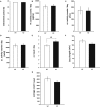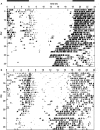Disrupted Ultradian Activity Rhythms and Differential Expression of Several Clock Genes in Interleukin-6-Deficient Mice
- PMID: 28382017
- PMCID: PMC5360714
- DOI: 10.3389/fneur.2017.00099
Disrupted Ultradian Activity Rhythms and Differential Expression of Several Clock Genes in Interleukin-6-Deficient Mice
Abstract
The characteristics of the cycles of activity and rest stand out among the most intensively investigated aspects of circadian rhythmicity in humans and experimental animals. Alterations in the circadian patterns of activity and rest are strongly linked to cognitive and emotional dysfunctions in severe mental illnesses such as Alzheimer's disease (AD) and major depression (MDD). The proinflammatory cytokine interleukin 6 (IL-6) has been prominently associated with the pathogenesis of AD and MDD. However, the potential involvement of IL-6 in the modulation of the diurnal rhythms of activity and rest has not been investigated. Here, we set out to study the role of IL-6 in circadian rhythmicity through the characterization of patterns of behavioral locomotor activity in IL-6 knockout (IL-6 KO) mice and wild-type littermate controls. Deletion of IL-6 did not alter the length of the circadian period or the amount of locomotor activity under either light-entrained or free-running conditions. IL-6 KO mice also presented a normal phase shift in response to light exposure at night. However, the temporal architecture of the behavioral rhythmicity throughout the day, as characterized by the quantity of ultradian activity bouts, was significantly impaired under light-entrained and free-running conditions in IL-6 KO. Moreover, the assessment of clock gene expression in the hippocampus, a brain region involved in AD and depression, revealed altered levels of cry1, dec2, and rev-erb-beta in IL-6 KO mice. These data propose that IL-6 participates in the regulation of ultradian activity/rest rhythmicity and clock gene expression in the mammalian brain. Furthermore, we propose IL-6-dependent circadian misalignment as a common pathogenetic principle in some neurodegenerative and neuropsychiatric disorders.
Keywords: behavior; circadian activity; clock gene; hippocampus; interleukin 6; mouse.
Figures





Similar articles
-
RCAN1 knockout and overexpression recapitulate an ensemble of rest-activity and circadian disruptions characteristic of Down syndrome, Alzheimer's disease, and normative aging.J Neurodev Disord. 2022 May 24;14(1):33. doi: 10.1186/s11689-022-09444-y. J Neurodev Disord. 2022. PMID: 35610565 Free PMC article.
-
Fluoxetine normalizes disrupted light-induced entrainment, fragmented ultradian rhythms and altered hippocampal clock gene expression in an animal model of high trait anxiety- and depression-related behavior.Ann Med. 2016;48(1-2):17-27. doi: 10.3109/07853890.2015.1122216. Epub 2015 Dec 18. Ann Med. 2016. PMID: 26679264 Free PMC article.
-
Dysregulated clock gene expression and abnormal diurnal regulation of hippocampal inhibitory transmission and spatial memory in amyloid precursor protein transgenic mice.Neurobiol Dis. 2021 Oct;158:105454. doi: 10.1016/j.nbd.2021.105454. Epub 2021 Jul 30. Neurobiol Dis. 2021. PMID: 34333153 Free PMC article.
-
Misalignment of Circadian Rhythms in Diet-Induced Obesity.Adv Exp Med Biol. 2024;1460:27-71. doi: 10.1007/978-3-031-63657-8_2. Adv Exp Med Biol. 2024. PMID: 39287848 Review.
-
Rev-erb-alpha: an integrator of circadian rhythms and metabolism.J Appl Physiol (1985). 2009 Dec;107(6):1972-80. doi: 10.1152/japplphysiol.00570.2009. Epub 2009 Aug 20. J Appl Physiol (1985). 2009. PMID: 19696364 Free PMC article. Review.
Cited by
-
Circadian Clock, Glucocorticoids and NF-κB Signaling in Neuroinflammation- Implicating Glucocorticoid Induced Leucine Zipper as a Molecular Link.ASN Neuro. 2022 Jan-Dec;14:17590914221120190. doi: 10.1177/17590914221120190. ASN Neuro. 2022. PMID: 36317290 Free PMC article. Review.
-
Physiological Rhythms and Biological Variation of Biomolecules: The Road to Personalized Laboratory Medicine.Int J Mol Sci. 2023 Mar 27;24(7):6275. doi: 10.3390/ijms24076275. Int J Mol Sci. 2023. PMID: 37047252 Free PMC article.
-
Role of Proinflammatory Cytokines in Feedback Modulation of Circadian Clock Gene Rhythms by Saturated Fatty Acids.Sci Rep. 2019 Jun 20;9(1):8909. doi: 10.1038/s41598-019-45322-9. Sci Rep. 2019. PMID: 31222133 Free PMC article.
-
Diminished circadian and ultradian rhythms of human brain activity in pathological tissue in vivo.Nat Commun. 2024 Oct 2;15(1):8527. doi: 10.1038/s41467-024-52769-6. Nat Commun. 2024. PMID: 39358327 Free PMC article.
-
PROVIT-CLOCK: A Potential Influence of Probiotics and Vitamin B7 Add-On Treatment and Metabolites on Clock Gene Expression in Major Depression.Neuropsychobiology. 2024;83(3-4):135-151. doi: 10.1159/000538781. Epub 2024 May 22. Neuropsychobiology. 2024. PMID: 38776887 Free PMC article. Clinical Trial.
References
-
- Klaffke S, Staedt J. Sundowning and circadian rhythm disorders in dementia. Acta Neurol Belg (2006) 106(4):168–75. - PubMed
Grants and funding
LinkOut - more resources
Full Text Sources
Other Literature Sources
Molecular Biology Databases
Research Materials

